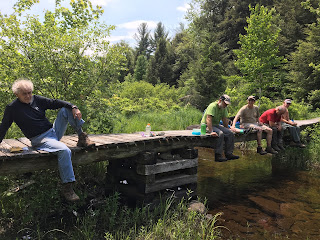June 10 and 13, 2017
This lengthy bridge spans an old beaver meadow, now just a stream surrounded by an occasionally wet field. Last year, one of the old telephone poles serving as stringers for this bridge gave way and was temporarily shored up over the winter.
Last Saturday a team of six volunteers transported about 2000lbs of materials from the road down to the work site--including a 16ft long telephone pole estimated to weigh around 600lbs. Beartown State Forest donated the used pole for this project.
 |
| Wheels make all the difference |
Using a trail cart, we were able to move the pole with three people, except where we had to lift the cart (and the pole) over the rocky stream between the road and Cooper Brook.
 |
| Lunch Break |
In addition to the pole, day one of the project was also spent transporting material for 92 new planks to replace about 75% of the existing planks on the bridge. We got started on the far end with plank replacement before wrapping up for the day.
On Day two, we stripped all the planks off of the broken stringer and removed it from the cribbing that supports the bridge. Clearly, time had come for replacement, as the thing pretty much crumbled as we pried it off of its supports.
 |
| Prying off the south end |
 |
| The north end was easy |
 |
| Carefully moving the new pole into place |
We then carefully moved the new pole into position, moving it a foot at a time, using the adjacent stringer for support. We were then able to roll it into position, and secure it to the cribbing at each end.
A little work with a draw knife to smooth the transition between new and existing stringers, and we were ready to install planks on the new section. Meanwhile, along the remainder of the bridge, we also pulled up older, failing planks and replaced them with new ones.
 |
| Plank replacement |
The entire bridge uses 6 stringers like the one we replaced, two of them over 20ft long. While at the time the bridge was originally installed the area supported an active beaver population, at present the area is reverting to meadow and we may want to consider an alternative way to cross the stream, rather than needing to maintain and repair such a large structure. Some ideas include just creating a span across the main stream and step stones or bog bridges over the marshy areas, using the old beaver dam as a walkway (a long-established method in Vermont and Maine), or using large step stones to create a permanent route across the entire area.


